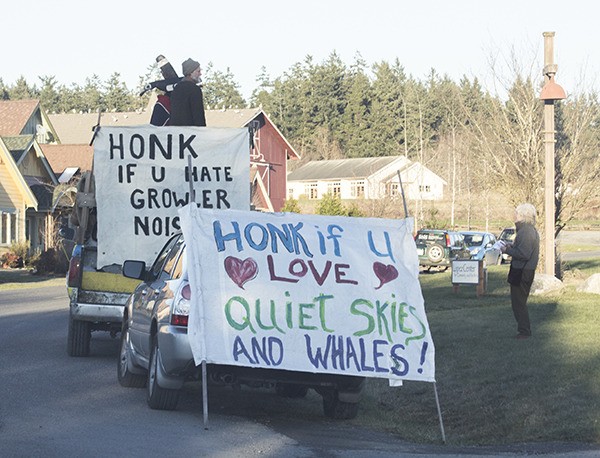“Honk if you like quiet skies” was written in bright letters and posted outside of the Lopez Center for Community and the Arts where the Navy held its first ever scoping meeting on Lopez on Dec. 3. Just a few feet down the road, dressed in down jackets Stanley and Kip Greenthal passed out blue papers labeled “Growler EIS Scoping Meeting.”
“This is our chance to show the Navy that we are impacted and do not want an escalation of noise and overhead flights from more Growlers,” said the flyer.
The noise from thousands of engine tests and training runs by new EA 18G Growlers and other planes at Naval Air Station Whidbey and Outlying Landing Field Coupeville has generated outcry this year, mainly from Lopez Island. At a meeting held by Rep. Rick Larsen in early October, Lopezians asked for the Navy to come to Lopez to discuss the noise pollution from the aircraft.
Inside the community center, 25 representatives for the Navy answered those requests and spoke with islanders at different booths labeled public involvement, Growler operations and aircraft noise.
More growlers?
County Councilman Jamie Stephens said that the Navy’s visit to Lopez is thanks to Rep. Rick Larsen push for the event.
“I think this is progress,” said Stephens, watching as Lopezians approached the various booths. “The number of people that have showed up is impressive.”
The meeting coincides with Larsen’s vote on Dec. 4 to allow the purchase of five additional A-18G Growlers. This brings the total number of Growlers that Congress will purchase from 135 to 140.
“Congress’ decision to buy five more Growlers indicates the planes’ importance to our national defense in this age of new technology, and continues to underscore the national commitment to maintaining Naval Air Station Whidbey Island as one of our country’s preeminent Navy bases,” Larsen said in a recent press release.
Currently, there are 82 Growlers actively flying out of NASWI and 12 used as backup.
The noise
Over the last several months the San Juan County Council collected data from islanders on a jet noise complaint website.
The site received 871 reports, mostly concentrated on the south end of Lopez. Two hundred and eighteen of those reports came from 6 a.m. to noon and 224 came after 9 p.m. The data also shows that 150 people reported a low rumble and 240 reported extremely loud noise.
Stephens hopes the meeting on Lopez is a step closer to mitigate the noise pollution. He wants the Navy will implement Hush Houses to reroute the noise from the revving of engines upward and thus creating less sound pollution, and structures at the end of the runway that you see at commercial airports that push the noise upwards. At the aircraft noise booth there is sign explaining that a noise study will be conducted as part of the EIS and will evaluate sleep disturbance, indoor speech interference and classroom listening interference.
Stephens hopes that the Navy will test noises levels on Lopez that is the equivalent to what people are actually hearing. He is concerned that the Growlers are causing problems both on land and sea.
“The noise is affecting us so it has to be affecting marine life,” said Stephens.
Scoping process
The highlight of the meeting for Stephens was that the Navy has extended the scoping process, allowing people to add official comments. Islanders could have a stenographer record their comment or write it down themselves. People also have until Jan. 9 to submit their comments online at www.whidbeyeis.com or by mail to EA-18G Growler EIS Project Manager, Naval Facilities Engineering Command Atlantic, 6506 Hampton Boulevard, Norfolk, VA 23508 Attn: Code EV21/SS.



